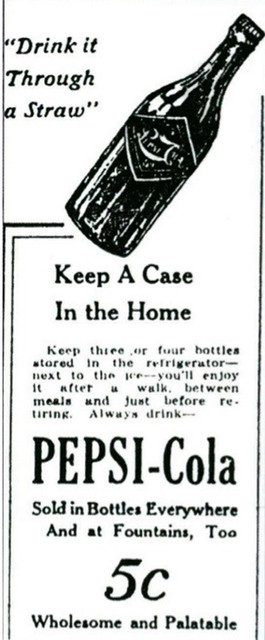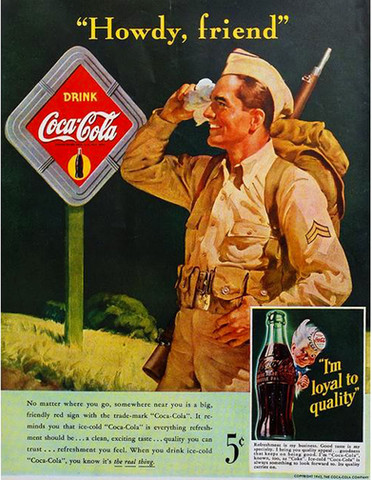Tracing over a century of Cola Wars through Ads - Pepsi & Coke's famous rivalry
- Kanhaiya Maheshwary
- Oct 3, 2020
- 5 min read
The world has seen enough brand wars, especially in markets that are defined by duopoly or oligopoly. McDonalds vs Burger King, VISA vs American Express, Starbucks vs Dunkin' Donuts, DC vs Marvel. However, the marketing world unanimously acknowledges that nothing beats the rivalry of Coke and Pepsi. For over a century now, both of them have fought each other everywhere - inside the sports stadiums, in rural shops, at political rallies, and just about everywhere else; and it shows no signs of slowing down.

The rivalry is so bitter that in 1985, when a Coke and a Pepsi employee were found to be dating, Coke fired its employee. Coke showed how seriously it takes this rivalry again in 2003 when it fired one of its truck drivers. The reason? He was found sipping a bottle of Pepsi!
History
To begin with, Coca Cola is the earlier of the two brands, having being founded by John S. Pemberton in 1886 in Atlanta, GA. Pepsi Cola, on the other hand, was born out of a vision to emulate the success of Coca Cola by a physician named Caleb D. Bradham in 1898 in New Bern, North Carolina. The cola at the end of Pepsi was added to send across the message that it was something similar to Coca Cola. Over time, both the brands grew massively, and are today 2 of the top most recognizable brands in the world.
In fact, if several researchers are to be believed, Coca Cola is the second most recognizable word in the world after the word 'Okay'!
Brand Positioning
The brand positioning of both these brands has always been different. Coca Cola was always about nostalgia, happiness, and family, whereas Pepsi has positioned itself around youthfulness and vibrant energy. However, they do overlap a bit when it comes to being a drink that brings people together to share some great moments.
Key moments of rivalry over 100 years
The battle of Price
In the early 1900s, Coke was already a more dominant brand, and Pepsi was following suit. Some of their earlier battles were fought over price and packaging innovation. Both of them positioned themselves as a 5 cent drink. In order to differentiate, Pepsi gaining started offering straws (a new invention) along with the drink bottles. Over the course of time, Pepsi actually increased its quantity whilst retaining the 5 cent price, whereas Coke increased its price from 5 cents.
The Great Depression and Rebound
During the Great Depression, businesses were going down rapidly. First mover Coke had both the volumes and sales to keep itself going, but Pepsi wasn't so fortunate. In 1931, Pepsi filed for bankruptcy. To give one final punch to Pepsi's then-dwindling fortunes, Coke came out with an ad announcing how many bottles it sells everyday. But eventually raised enough money to get its business going again in 1940. In order to let people know that it was back, Pepsi came out with this print ad which reminded people of who they were, in case the brand had started fading away from people's memories.
(L) Coke announcing its good business. (R) Pepsi announcing its comeback
Cola Wars during the World War II
In 1939, with the American troops stationed in Germany, Coca Cola actually opened a bottling unit there. Back then, the country was under Hitler's regime. Coca Cola's widely popular drink Fanta was actually conceived in that unit. Coca Cola came up with ads reminding the Americans that the familiar 'red sign' (Coke logo) was accompanying them even in Germany. To counter this, Pepsi put on its patriotic hat and claimed in its ads that it is helping the American troops during World War II because Pepsi's servings contained more calories and hence, was providing more energy to the troops!
Coke and Pepsi's ads during the World War II
Pepsi grabs a major market share in Minority markets
During the 1947, at a time when people from the Black community were still referred to as 'Negros' (pardon me for using this word) and hardly enjoyed any civil or political freedom, Pepsi made the bold move to depict the Black community in its ads. While this move was met with a lot of resentment and boycotting from several racist groups down south, Pepsi not only entered into the homes of the Black community but also their hearts.
(L) Pepsi's 1949 ad featuring the Black community. (R) Coke's ad in 1955
Coca Cola, after watching Pepsi's success, came out with a color print ad depicting the Black community. However, it was 6 years after Pepsi's ad.
Politics and Cola Wars - The famous Russian sip
Pepsi had signed the then Vice President Richard Nixon as its international brand ambassador. When Nixon was about to meet Russian President Nikita Khrushchev, Pepsi convinced the American to get the Russian photographed with a glass of Pepsi. The photo-op was successful, and Pepsi were able to claim that even the communists couldn't escape the taste of Pepsi. On the other hand, Coca Cola didn't have anything to show in this regards.

Russian President Nikita Khrushchev photographed with a Pepsi
Blind Test - David takes the lead in David (Pepsi) vs Goliath (Coca Cola)
In 1975, Pepsi's representatives announced a Blind taste test to determine the winner once and for all. Booths were setup across shopping centers and malls in US. Respondents were given unlabelled white cups, containing Coke and Pepsi. Only the representatives knew which cup held which drink. After a few months of activity, it was declared that far more people loved Pepsi as compared to Coca Cola.

Pepsi declared itself the winner, and in a fearful response, Coke actually came out with a 'New Coke' which was far sweeter in order to appease people. However, loyalists were not just unimpressed, they were dejected. For the fear of Coke abandoning original Coke's production in favor of New Coke, loyalists started hoarding crates of the original Coke and started selling them in the black market! Eventually, Coke had to come back with a drink called the 'Original Coke'.
Cola Wars reaches the Space
In a bid to do something different and gain the upper hand, Coca Cola was developing special cans in 1985 that could be sent to space with NASA's astronauts. Pepsi got an inkling of this, and started developing its own space-friendly cans. The battle was so intense that even White House officials invariable found themselves being dragged into this. Finally, 4 cans of each brand were sent to space with the astronauts in the Space Shuttler Challenge. The final verdict, however, was that both Pepsi and Coke tasted pretty unimpressive to the astronauts.
Pepsi still went ahead and claimed in its ads that it was 'one giant sip for mankind'!
(L) Coke's space can. (C) Coke and Pepsi's cans. (R) Pepsi's space can
Pepsi and Coca Cola have been battling out the Cola wars ever since. Both have found ways to one-up each other at various occasions. They've signed record deals with rival pop-stars, got endorsed by competing athletes and soccer players. When it comes to the Cola market, however, Coca Cola always had the upper hand and continues to do so. But Pepsi can take pride in the fact that it is running a hugely successful snack business, and at an overall market cap level is slightly ahead at $188 billion as compared to Coke's $185 billion. Again, not a huge difference considering the epic proportion of numbers, but in a war where every small victory has been celebrated, why not this?

























Comments